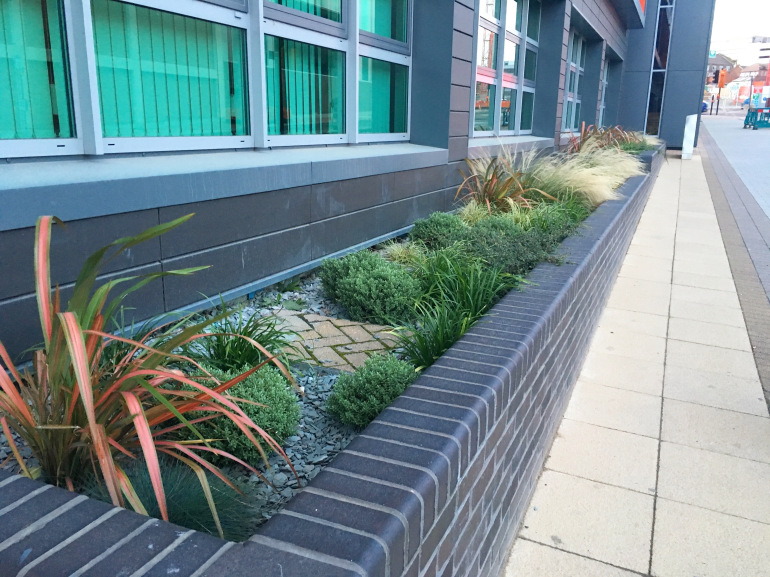Green infrastructure in reducing urban runoff - does size matter?

Siti Nur Hannah Ismail
At a recent Flower Show held in Chatsworth (The RHS Chatsworth Flower Show 2017), the Royal Horticultural Society and the Landscape Department designed a garden specifically to address the effects of climate change, The Garden for a Changing Climate. Various types of shrubs and low-growing plants were displayed in the garden to increase awareness of the need to adapt gardens to a changing climate. Selection was based on functional traits that contribute to reducing negative effects associated with extreme weather events, such as flooding. The displays were very popular, and attracted much attention from gardeners and visitors to the show - most saying that they would like to have these in their own garden because not only are they beautiful and colourful, but they can also help save the environment!
Displays such as this are made possible from results of focussed research. The PhD research presented here looked into the role of low-growing plants for rainfall interception. Aimed at contributing to the scientific knowledge that supports the application of small-scale green infrastructure in mitigating flood risks, this research investigated how different leaf traits affected moisture retention.
More than 50% of the world’s population lives in urban areas, and this number is expected to increase each year. As urban populations continue to grow, building developments expand, replacing ‘soft’ elements (trees and grass) with rigid, concrete environments. This increase in impermeable surfaces results in loss of soil permeability, further reducing opportunities for tree planting to enhance environmental benefits.
The impact of urbanization becomes more critical when combined with the effects of climate change, which causes a number of threats, including intensification and increased frequency of rainfall events. The inability for water to infiltrate into the soil reduces the performance of drainage systems and increases risks of urban flooding.
Green infrastructure (GI) implementation has become a trend in the past decade, intended to alleviate environmental problems, including combating urban heat island effects and mitigating flooding and droughts, whilst also offering habitats for wildlife, enhancing biodiversity and creating amenity spaces for social interaction. GI is perceived to be a more ‘sustainable’ solution to help manage runoff volumes and flows in urban areas compared to conventional piped drainage systems (Stovin, et al. 2012).
GI can be designed in various forms and sizes, depending on the functions they aim to provide. The potential of large trees and forests for rainfall interception to slow down runoff has been well documented. However, less interest has been shown in the role of smaller plants (i.e. shrubs, groundcovers). Because of their small stature and low overall surface area, low-growing plants can be perceived to intercept and store less moisture (Tromble, 1983). However, smaller plants may well have what it takes to help reduce runoff flows, especially in the increasingly limited spaces of urban areas.
Experiments were conducted to compare three species of low-growing plants (Bergenia cordifolia, Vinca minor and Dianthus ‘Haytor White’), varying in leaf characteristics and canopy structure, against each other and against two non-vegetated treatments to represent bare soil and impervious surface. To determine their ability to retain water, simulated rainfall was applied with the soil already at field capacity. Retention was assessed by collecting and measuring runoff generated from each system. More detail on the research methodology is presented on the Centre for Designed Ecology website.
Results suggest that the presence of vegetation plays an important role in retaining moisture, with significant retention differences between by bare soil and vegetated treatments. It is important to note, however, that interception is highly influenced by rainfall characteristics (intensity, frequency, duration). A system with 1m2 of low-growing vegetation could retain between 37% and 49% of applied rainfall, depending on leaf and canopy traits associated with different genotypes. Fine-leaved species with linear-shaped leaves (Dianthus ‘Haytor White’) retained a proportionally greater volume of rainwater than broad-leaved species (Bergenia cordifolia) - broadly agreeing with work on trees. Plant leaf traits play an important role in influencing water retention in the canopy.
The contribution of low-growing plants should not be ignored - the principles identified here pertaining to leaf characteristics may help to adopt more effective planting design for urban landscapes in the future.
References:
Tromble, J. M. (1983). Interception of rainfall by Tarbush. Journal of Range Management, 36(4), p. 525-526.
Stovin, V., Vesuviano, G. and Kasmin, H. (2012). The hydrological performance of a green roof test bed under UK climatic conditions, Journal of Hydrology, 414-415, pp. 148 – 161.
In the article, you write very well in giving knowledge about the landscape. These tips are amazing to work. I will sure follow the tips. Thanks, to write an article on the landscape.
LikeLike